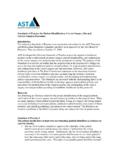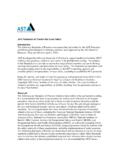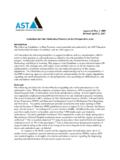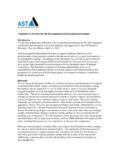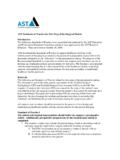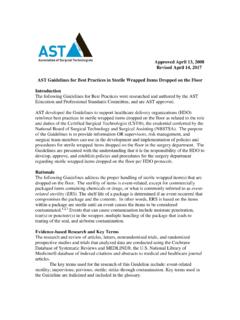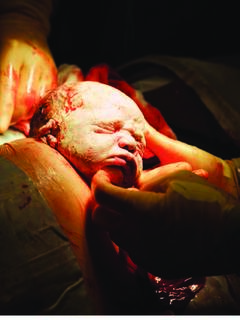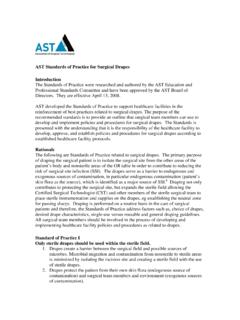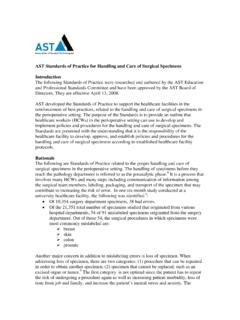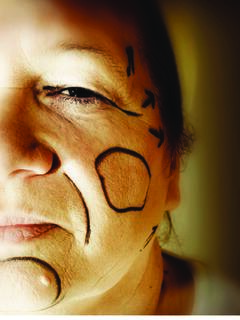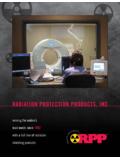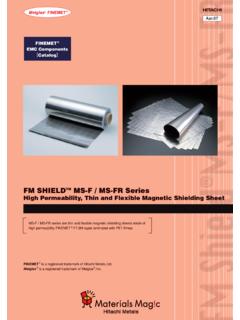Transcription of Standard Ionizing Radiation Exposure
1 AST standards of Practice for Ionizing Radiation Exposure in the Perioperative Setting The following standards of Practice were researched and authored by the AST Education and Professional standards Committee and have been approved by the AST Board of Directors. They are effective October 8, 2010. AST developed the following standards of Practice to support health care facilities in the reinforcement of best practices related to Ionizing Radiation Exposure (subsequently referred to as X-rays or Radiation ) in the perioperative setting. The purpose of the standards is to provide an outline that health care providers in the perioperative setting can use to develop and implement policies and procedures for minimizing Radiation Exposure . The standards are presented with the understanding that it is the responsibility of the health care facility to develop, approve and establish policies and procedures for Radiation safety for the surgical patient and personnel according to established health care facility protocols.
2 Rationale The following are standards of Practice related to minimizing Radiation Exposure . Soon after X-rays were discovered in 1895, the harmful effects were also discovered and published. The first report of harmful physical effects was initially published in the British Medical Journal in As more individuals sustained Radiation injuries, and when radiologist William Ironside Bruce died in 1921, public concern rose and lead to the development of organizations such as the US-based National Council on Radiation Protection and Measurements, and the International Commission on Radiation These agencies have developed many recommendations and guidelines that aid health care facilities in the development of policies and procedures to reduce patient and health care worker (HCW) Exposure to X-rays.
3 One of the most important principles that resulted is The general philosophy followed by most health care facilities in minimizing Radiation dose is that all exposures must be justified; and, further, that they must be kept as low as reasonably achievable (ALARA); economic and social factors are also taken into The ALARA concept applies to all HCWs, who may be exposed to Radiation . It also represents a commitment by health care facilities to provide an environment where ALARA can be effectively implemented on a daily basis. The surgical personnel should be involved in supporting ALARA policies and procedures in the health care facility. As previously mentioned, there are several regulatory agencies that establish the various guidelines, recommendations and mandatory policies related to the use of X-rays.
4 These RSOPs reflect the research of the following agencies publications: American College of Radiology (ACR); Centers for Disease Control and Prevention Radiation Safety Committee; Conference of Radiation Control Program Directors (CRCPD); International Commission on Radiological Protection (ICRP); National Council on Radiation Protection and Measurements (NCRP); and the US Nuclear Regulatory Commission (NRC). Standard of Practice I Surgery technologists should complete entry-level education related to Radiation safety as well as annual continuing education to receive updates on health care facility policies and procedures. 1. Surgery technology students should receive entry-level education, per the requirements of the Core Curriculum for Surgical Technology to include:8 2.
5 A. Physiological effects of Radiation B. Radiation safety C. Use of Radiation safety shielding devices D. Use of dosimeters E. Requirements by regulatory agencies 3. Surgical technology and surgical assisting practitioners should complete annual continuing education to remain current in their knowledge of Radiation safety and practices, health care facility policies and procedures, and receive updates on new regulatory requirements. A. The Radiation Safety Officer (RSO) should document the continuing education as well as maintain the documentation. Standard of Practice II Shielding devices should be properly cared for according to guidelines provided by experts in the Radiation safety community. 1. The Joint Commission requires its accredited health care facilities to inspect lead aprons.
6 However, the commission does not provide guidelines and/or standards on how the inspections should be conducted, leaving it up to the facilities to design and schedule safety A. New leaded shielding devices should be inspected and tested for attenuation effectiveness and integrity prior to being placed into service. B. Leaded shielding devices should inspected and tested at least annually and upon request by a C. The following are recommendations for the inspection and testing of leaded shielding devices: 14,16, 1) Leaded shielding devices should be physically examined for gross defects including tears, perforations and thinning creases. Devices that do not pass physical inspection should be removed from use and disposed. 2) Devices that pass physical inspection should be examined fluoroscopically using manual settings.
7 Automatic brightness control should not be used, because it will increase the tube current and voltage that results in unnecessary Radiation Exposure to medical personnel. Shielded areas will appear dark and defects, seams and stitching will appear light. 3) If a health care facility does not have fluoroscopic equipment (eg smaller clinics), it is possible to radiographically examine devices. 4) Health care facilities should establish criteria for rejecting devices. provided the following guidelines for removing a device from service: defect is greater than 15 square mm, unless the defect is not located over a critical organ; defect is 670 square mm along a seam, overlapped area, or back of the device; thyroid lead shields with defect greater than 11 square 5) Devices that pass all inspections should have a unique identifier that includes an identification number, date of inspection, due date for next inspection and lead thickness of either mm or mm.
8 6) Defective devices should be immediately removed from service and disposed of properly. Under the Resource Conservation and Recovery Act, the Environmental Protection Agency has established regulations for the disposal of hazardous wastes. Leaded shielding devices meet the criteria for hazardous waste, and the health care facility should follow regulations for proper 7) Health care facility should be familiar with, and have available, state Radiation control regulations which can vary from the guidelines provided 2. Proper storage of leaded shield devices is important to maintain the integrity of the lead. Lead aprons and thyroid shields should be stored on a flat surface or preferably hung vertically (commercial apron racks are available); lead aprons should be hung from the shoulders.
9 A separate apron rack should be available to hang mm, mm and maternity lead aprons, and the racks labeled with the size and/or type. The devices should never be folded to avoid cracking. 3. Recommendations for cleaning devices include using cold water and a mild detergent solution, but do not use solvents, including bleach that would affect nylon fabric, urethane, polyvinyl chloride or manmade ,20 Standard of Practice III The surgical technologist and surgical assistant should practice the triad of the fundamental principles of Radiation protection: time, distance, shielding. All other standards of Radiation safety are based upon these three principles. 1. The amount of Radiation received is controlled by time of Exposure . A. The surgical technologist and surgical assistant should practice safety standards for limiting the time of Exposure to Radiation .
10 2. The surgical technologist and surgical assistant should be familiar with the Inverse Square Law related to Radiation safety that states the Exposure rate from a point source of Radiation is inversely proportional to the square of the distance from the ,8,17 A. In the operating room, the following principle applies: the distance from a point source of Radiation is doubled, the Exposure is quartered (eg, CST standing four meters from an X-ray source will be exposed to as much Radiation as a CSFA standing two meters from the source). Therefore, the surgical technologist and surgical assistant should control the amount of Radiation received by controlling the distance from the source of Radiation . B. It is recommended all surgical personnel during X-ray procedures should stand as far away as possible (at least two meters) from the source of the Radiation .
